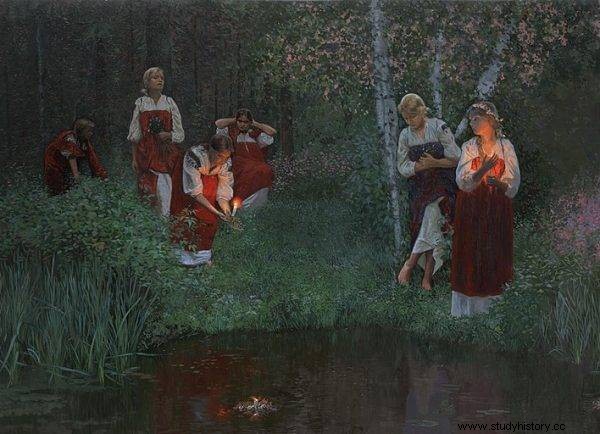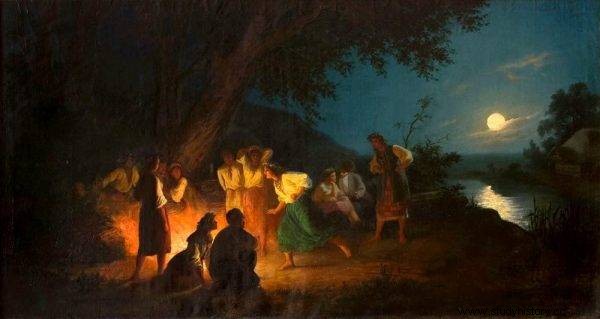What do powdered boar testicles have to do with fertilization? How was newborn baby's jaundice treated? What did you have to drink to avoid becoming pregnant? Here are some surprising facts about the procreation of our ancestors.
The cult of fertility and living in harmony with nature had a great impact on the sexual life of our ancestors, and thus - also on their methods of fertilization control. On the occasion of the publication of the latest book by Tomasz Kosiński, "Erotic Life of the Slavs", let's take a look at some of them.
Where do babies come from?
In the old days, there was no detailed knowledge of the women's menstrual cycle and the technical side of fertilization. Conclusions were drawn from observing nature. Therefore, it was widely believed that pregnancy could occur when the female flower blossoms. This was commonly associated with the end of menstruation. As we read in "Erotic life of the Slavs":
It was assumed that the "new beginning" might not appear until some time after the baby is born, as in the case of the natural cyclicality of fruit trees and other plants. Therefore, it was a common belief that a breastfeeding woman could not be impregnated .

The cult of fertility and living in harmony with nature had a big impact on the sexual life of our ancestors
Pregnancy was treated as a marriage obligation. High mortality in the old days, as well as a huge amount of work on the farm meant that great importance was attached to the size of the family. Married couples with a small group of children were viewed not very favorably. Methods aimed at increasing fertility, especially of women, were also common.
Potency drugs
As we read in Tomasz Kosiński's book "Erotic Life of the Slavs":
One of the common means of supporting female fertility in medieval Poland and Rus was eating the sexual parts of a hog, hare, rooster and other animals considered to be symbols of fertility . Serbs, in turn, in case of problems with procreation, recommended an old rooster soup sprinkled with powdered testicles of a wild boar (for a male) or the uterus of a female hare (for a female) drained and soaked in water.

The text was created, among others based on the book by Tomasz Kosiński "Życie erotic Słowian", which has just been released by the Bellona publishing house. Buy now "
Other methods of supporting fertility were:passing a piece of bread from the mouth to the mouth from a pregnant woman, drinking the blood of an obstetrician or umbilical cord, or wearing a dirty shirt after a woman in labor. Peculiar fruits and jumping over the Midsummer fire or smacking the genitals with a pregnant cow's excrement mixed with a rooster's bun could also increase the chance of getting pregnant.
Water associated with the goddess Mokosz played a special role in fertility. Drinking from miraculous springs in the presence of a pregnant woman was supposed to help women trying to conceive . From the book by Tomasz Kosiński, we learn that water had a special place in old beliefs:
Ethnographic accounts show that in some regions of the Slavic region the people believed that the souls of unborn children reside in water, in the marshes, rushes and wells, where they are looked after by nymphs or other water creatures. Water was associated with the new life, which, as we know, is also justified from a scientific point of view.
In pain you will give birth
In the old days, births took place at home or in nature. Midwives under the watchful eye of medics began to be trained only in the 18th century. They were supposed to help less wealthy women and educate the village grandmothers who had assisted at birth until now. The first midwife school was established in 1780. Its graduates, apart from delivering births, also performed abortions. It was because of this activity that they were also called angel manufacturers .

Special fruits and jumping over the Midsummer fire could also increase the chance of getting pregnant
Before midwives rushed to rescue rural women, the current problems related to childbirth were solved with available means adequate to knowledge. As we read in the book "Erotic life of the Slavs":
If the baby was born with jaundice, a piece of gold was placed on the bottom of the tub, and later - a wedding ring to help the baby overcome this disease. ... . The chamomile decoction, which should be drunk with vodka, had a similar application.
There were also other, much more drastic methods. The puerperal woman was dragged across the floor, hung upside down, and her belly was kneaded. "With the wrong position of the fetus, the woman in labor was led to a crossroads, which was to provoke the child to find a way out into the world". Most of the ways of solving the problems of giving birth to women have been associated with great suffering. Some resulted in the mother's death.
Fertile and infertile
In the old days, contraception was mainly taken care of by women. As we read in the latest book by Tomasz Kosiński:"According to the folk tradition women who did not want to get pregnant put their fingers under each other during intercourse, and their number was to indicate the desired number of infertile years ”.
Another method of contraception was to pour menstrual blood on a lilac bush or pour it into a lake. The women also drank various infusions and decoctions that were supposed to magically protect them. Such specifics included the specific made from dried thyme herb.

The women also drank various infusions and decoctions that were supposed to magically protect them.
However, when the previously described methods failed and the pregnancy was unwanted, women resorted to various types of abortion methods. Kosiński mentions them in the "Erotic Life of the Slavs":
They drank various potions of questionable effectiveness, such as:water with gunpowder, ergot decoction with a strong decongestant effect, spring rye decoction (dosed three times per glass), rye flower, wormwood, marigold, periwinkle, rosemary, willow, mistletoe (berries and plants), calamus root, larkspur (with vodka and herbaceous mood), sabina, saffron, sage, spring silver, Savin juniper, black rose, mallow, wild boar root, mint, orchid (orchid), chamomile, soapwort or club moss, and even soapy water.
rue decoction was also extremely popular, which was used not only for aborting the fetus, but also as a contraceptive for men .
Love and betrayal
Another possibility was to use magic. It was believed that an unwanted pregnancy was the result of a thrown spell. It was therefore necessary to pray to the gods to reverse it. The effects of marital infidelity were to be removed by sitting at midnight under a fruit tree and scraping its bark . Additionally, there were imploring words, "Carry for me and I will flower for you."
Abortion could also be performed mechanically. For this purpose, sharp objects were used or methods such as lifting loads, placing stones on the stomach or deliberately hitting it with a fist.
These and other aspects of the sexual life of our ancestors are discussed in the latest book by Tomasz Kosiński, "Erotic Life of the Slavs".
[P. C.]
Bibliographer:
- Abramski, Doctors, barbers, charlatans. State of Medicine in Stanisławów Poland, 1764 - 1795 , Katowice 1992.
- Kosiński, Erotic life of the Slavs , Warsaw 2021.
- Kuchowicz, Leki and the witchcraft of the old village. Health condition of Polish serfdom, Warsaw 1954.
